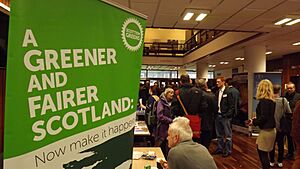Scottish Greens facts for kids
Quick facts for kids
Scottish Green Party
Pàrtaidh Uaine na h-Alba (Scottish Gaelic)
|
|
|---|---|
 |
|
| Co-Leaders |
|
| Council Co-Convenors |
|
| Executive Co-Chairs |
|
| Founded | 1990 |
| Preceded by | Green Party (UK) |
| Headquarters | 17b Graham Street Edinburgh EH6 5QN |
| Youth wing | Scottish Young Greens |
| Women's wing | Scottish Greens Women's Network |
| LGBTQ+ wing | Rainbow Greens |
| Membership (2023) | |
| Ideology |
|
| Political position | Centre-left to left-wing |
| European affiliation | European Green Party |
| International affiliation | Global Greens |
| Colours | Green |
| Slogan | For People. For Planet. |
| Scottish seats in the House of Commons |
0 / 59
|
| Scottish Parliament |
7 / 129
|
| Local government in Scotland |
36 / 1,227
|
| Party flag | |
 |
|
The Scottish Greens (also known as the Scottish Green Party; Scottish Gaelic: Pàrtaidh Uaine na h-Alba) are a green political party in Scotland. The party has seven MSPs in the Scottish Parliament as of May 2021. As of the 2022 local elections, the party sits on 13 of the 32 Scottish local councils, with a total of 36 councillors. They held two ministerial posts in the first Yousaf government following a power-sharing agreement with the SNP from August 2021 until the end of the Bute House Agreement in April 2024, marking the first time Green Party politicians formed part of a government in the UK.
The Scottish Greens were created in 1990 when the former Green Party separated into two independent parties, representing Scotland and England and Wales. The party is affiliated to the Global Greens and the European Green Party.
Party membership increased dramatically following the Scottish independence referendum, during which it supported Scotland's independence from the United Kingdom.
Contents
Organisation
The Scottish Greens are fully independent, but work closely with the green parties from Ireland: the Green Party Northern Ireland and the Green Party of Ireland. Until October 2022, it also cooperated with the Green Party of England and Wales; this partnership was suspended due to differences of opinion on trans rights. It is a full member of the European Green Party. The party currently has seven MSPs and 35 councillors, but has no representation in Westminster.
Membership
Within days of the Scottish independence referendum being held, the membership swelled to more than 5,000. Launching its manifesto for the 2015 UK general election, the Scottish Greens stated a membership of over 8,500. By October 2015 the party were holding their biggest ever conference, with their membership standing at more than 9,000. In mid-2021 it had fallen back somewhat, reported as standing at 7,500. In April 2023, the number of members had risen to 7,646.
Conferences
The Scottish Greens hold conferences every Spring and Autumn, where members from throughout Scotland attend to deal with all the business of the party, with members voting on conference motions and policy motions.
Internal party bodies
There are two key bodies which steer the party between conferences: party council and the national executive. The party council can, with some exceptions, act as a more frequent conference on issues that appear outside conference season. The national executive oversees the day-to-day administration of party activities.
Branches
The party is made up of branches, who usually cover one or more local authority areas, and meet on a regular basis.
Representation groups
The Scottish Greens have six self-organised representation groups:
- Disabled Greens
- Greens of Colour
- Rainbow Greens (LGBT+ group)
- Scottish Green Trade Union Group
- Scottish Young Greens
- Women's Network
These groups have additional meetings and discussions which are separate from the main party meetings.
Ideology
The Scottish Greens are a party whose ideology is shaped by green politics, Scottish independence, Scottish republicanism and pro-Europeanism.
Co-leader Patrick Harvie has described the party's ideals as:
Of a liveable planet.
Of justice, equality and dignity for all people.
Of Scotland’s right to decide its own future - not because of attachment to one flag or another, but because of a clear, compelling vision of what a Green Scotland could be.
Four principles
According to the party's website, the Scottish Greens are committed to forming a sustainable society and are guided by four interconnected principles:
- Ecology.
- Equality.
- Radical democracy.
- Peace and nonviolence.
The party claims that, taken together, these principles give the party a holistic view that is in common with all green parties around the world.
Policy
While associated mainly with environmentalist policies, the party has a history of support for communitarian economic policies, including well-funded, locally controlled public services within the confines of a steady-state economy, is supportive of proportional representation and takes a progressive approach to social policies. The party is also strongly opposed to both nuclear power and the Trident nuclear programme.
The party's 2019 manifesto included pledges to implement a green new deal to tackle climate change and for future investment, the introduction of a universal basic income, and the phasing in of a four-day week, support for rent controls.
Climate change
The party favours strong action to combat climate change, including phasing out single-use plastic, the creation of more Low Emission Zones in cities and a ban on the sale of new petrol cars, diesel cars and fossil fuel boilers. The party also seeks "ambitious" climate action, and in 2019 abstained on the Climate Change (Emissions Reduction Targets) (Scotland) Bill claiming it was not "anywhere near meaningful action to address the climate emergency". However, the BBC News journalist Philip Sim argued in 2021 that since then the party position has shifted to "hitting these [carbon emissions reduction targets] than stretching them".
The party is also against oil and gas developments in Scotland, such as the proposed Cambo and Rosebank oil and gas fields.
In government, the party's ministers announced a ban on new waste incinerators and a new biodiversity strategy.
Transport
The Greens are against plans to dual the A9 and the A96, arguing that the plans are incompatible with climate commitments. Instead, the party advocates for the expansion of Scotland's railway network, such as a tunnel across the Forth constructed between Leith and Kirkcaldy, an aim to connect every town with more than 5,000 people to the railway network and to completely electrify the Scottish network by 2030.
The Scottish Greens also supported the nationalisation of ScotRail and Caledonian Sleeper, and advocates for "the whole of Scotland’s railways – both track and train – to be brought into public ownership". The party, as part of its co-operation agreement with the Scottish Government scrapped peak-time rail fares for at least one year.
The party also supports a wider nationalisation of all rail, bus and ferry companies, alongside further investment in walking, wheeling and cycling.
Scottish independence
It is the only party other than the SNP to both support Scottish independence and have representation in the Scottish Parliament. At the party's 2005 conference, a motion passed to support Scottish independence.
The Scottish Green Party supports Scotland having its own currency if it were to become an independent country. The party has said this would be in order to establish full economic independence, rather than being tied to the pound sterling.
The party backed the Scottish government's attempt to hold a second Scottish independence referendum in 2023, and made it a key part of its 2022 autumn conference.
However, in an interview at the party's 2023 autumn conference, co-leader Lorna Slater suggested that independence was not a "red line" for any future power-sharing deals with Scottish Labour, re-affirming similar comments during the independence referendum.
Leadership
The Scottish Greens is led by a six-person leadership team. This is made up of the co-leaders of the party, the co-chairs of the national executive of the party and the co-convenors of the party council.
The political leadership roles are generally held by a present or aspiring elected politician, while internal leadership is held by a mixture of ordinary members and aspiring or elected politicians.
Political leadership
Alongside many other green parties, the Scottish Greens initially shunned the idea of a singular leader, despite key party figures like Robin Harper commenting that it must "have an official Leader and face to represent it if it is to sustain political effectiveness." Increasingly, during Patrick Harvie's tenure as co-convenor, the role became more like a traditional party leader, as his profile as an MSP tended to overshadow his fellow co-convenor. In 2019, as a part of internal party reforms, the role of two co-leaders was introduced, with Patrick Harvie and Lorna Slater elected as inaugural co-leaders. A maximum of one of the co-leaders may identify as a man.
Unlike party leaders in most other political parties, the Scottish Greens' co-leaders are only elected for two year terms, after which they may seek re-election. Generally, incumbents are returned without opposition, but the inaugural co-leadership election, and 2015 co-convenorship election were contested.
| Co-leaders | Term start | Term end | |||
|---|---|---|---|---|---|
| Portrait | Name | Portrait | Name | ||
 |
Patrick Harvie
MSP for Glasgow (2003–present) |
Lorna Slater | 1 August 2019 | Incumbent | |
Internal leadership
The other four members of the party's leadership team are drawn from its national council and executive. They serve for two year terms, and are elected by a ballot of party members.
Party Council
Between conferences, the Party Council provides the forum for strategic decisions, policy discussions, oversight and branch coordination. The council is composed of two delegates from branches, usually branch co-convenors, representative and special interest groups. Its decisions can only be overridden by a party conference or AGM.
The council is currently led by council co-convenors Laura Moodie and Kate Nevens.
Party Executive Committee
The National Executive oversees the day-to-day administration of the party. It is led by two co-chairs, directly elected by party members, and who manage the party staff and its volunteer-led National Committees which focus on specific party functions like policy development or engagement with the European Greens. Its decisions may be overridden by the party council or conference.
It is presently chaired by Ross Greer and Carolynn Scrimgeour, who was co-opted after the resignation of Ellie Gomersall in December 2023. This committee also oversees the work of the elected National Committees; Finance & Fundraising, Elections & Campaigns, Policy, Membership and International.
See also
- Green politics
- List of advocates of republicanism in the United Kingdom
- List of environmental organisations
- Radical Independence Campaign
- Renewable energy in Scotland
- Scottish Campaign for Nuclear Disarmament
Related organisations
- European Federation of Green Parties
- Green Party Northern Ireland
- Green Party of England and Wales


